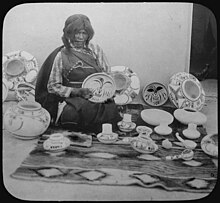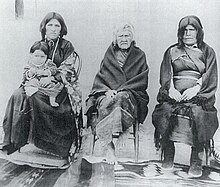Nampeyo
Nampeyo (* 1856 in Hano , Navajo County , Arizona , United States ; died 1942 ibid) was a potter of the Hopi - Indians .
life and work
Num-pa-yu, the snake that does not bite, was Nampeyo's maiden name. Iris Nampeyo was her English name. The potter became famous under the name Nampeyo. She was born in 1856 on a Hopi Indian reservation on a table mountain on the edge of the Painted Desert and the Colorado Plateau . Her birthplace, Hano Pueblo, lies in the east of the isolated, dry plateau First Mesa , together with the settlements Walpi in the west and Sichimovi in the middle. The highest point of the First Mesa is 1,800 meters above sea level .
Nampeyo learned the pottery craft from her grandmother, who worked the yellow clay without a potter's wheel and painted it with black motifs. Brushes made of yucca fibers and natural colors were used for painting. With several other Hopi potters, she made traditional Hopi pottery in the Jeddito and Awatovi tradition , which was traded by Lieutenant Thomas Keam. As early as 1881 she was able to earn a living with it.
4 to 5 km north of the Hano pueblos , the ruins of the Sikyatki pueblo , which was inhabited between 1375 and 1625, were uncovered under the direction of Jesse Walter Fewkes (1850–1930) . The pottery found in this settlement had a great influence on the work of Nampeyo. With her husband, Lesou / Lesso, who came from Walpi, she visited the excavation site and was impressed by the finely crafted and richly painted pottery that was found. She began to integrate the variety of shapes and motifs into her own work. After 1895 the so-called Sikyatki Revival style, also called Hopi Revival Pottery , emerged.
In 1925, Nampeyo's eyesight deteriorated until she became completely blind from a trachoma . She continued to fashion pottery that was painted by her family members. Her four daughters also became famous potters. Nampeyo worked with clay until the end of her life in 1942 . Her husband died in 1930. The couple had 4 daughters and a son. Well-known offspring are her daughter Fannie Nampeyo , granddaughter Elva Nampeyo and great-grandchildren Dan Namingha and Dextra Nampeyo Quotskuyva . In 2014, an exhibit was held at the Museum of Northern Arizona that featured exhibits from Nampeyo and some of her descendants.
Nampeyo left nothing in writing and only spoke Tewa , a language belonging to the Kiowa-Tano language family .
Photographic documentation
Nampeyo became the most famous and most photographed Indian potter. William Henry Jackson first photographed Nampeyo and the Pueblos in 1875. This was followed by photographs by Henry Peabody, Adam Clark Vroman, HFRobinson, John Karl Hillers, Tad Nichols, Edward Curtis and Ansel Adams . The Pueblo culture also became a popular photo opportunity for tourists who had booked a Fred Harvey bus tour or who turned off the nearby Route 66 individually by car .
Honors
- A crater on the planet Mercury was named after her by the International Astronomical Union in her honor.
- Posthumously , Nampeyo was inducted into the Arizona Women's Hall of Fame in 1986 .
literature
- Nampeyo and Her Pottery, Barbara Kramer, 1996, ISBN 978-0-82631-7-186
Web links
- Literature by and about Nampeyo in the catalog of the German National Library
Individual evidence
- ↑ Manataka American Indian Council Nampeyo - Hopi Master Potter , accessed September 7, 2014.
- ↑ Arizona State Museum Ancestral Hopi Pottery - A Nampeyo Showcase ( Memento of the original from February 8, 2008 in the Internet Archive ) Info: The archive link was automatically inserted and not yet checked. Please check the original and archive link according to the instructions and then remove this notice. , accessed September 7, 2014.
- ↑ Koshare Indian Museum Nampeyo ( Memento of the original from June 28, 2014 in the Internet Archive ) Info: The archive link was inserted automatically and has not yet been checked. Please check the original and archive link according to the instructions and then remove this notice. , accessed on September 7, 2014.
- ↑ Betsy Brunerː A family connection: New MNA exhibit focuses on family legacy of master potter Nampeyo , accessed on September 7, 2014 (English).
- ^ Gazetteer of Planetary Nomenclature Nampeyo Krater , accessed September 7, 2014.
- ↑ Barbara Kramerː Nampeyo and Her Pottery , accessed on September 7, 2014 (English).
| personal data | |
|---|---|
| SURNAME | Nampeyo |
| ALTERNATIVE NAMES | Nampeyo, Iris; Num-pa-yu, the snake that doesn't bite |
| BRIEF DESCRIPTION | Hopi Indian potter |
| DATE OF BIRTH | 1856 |
| PLACE OF BIRTH | Hano |
| DATE OF DEATH | 1942 |
| Place of death | Hano |



